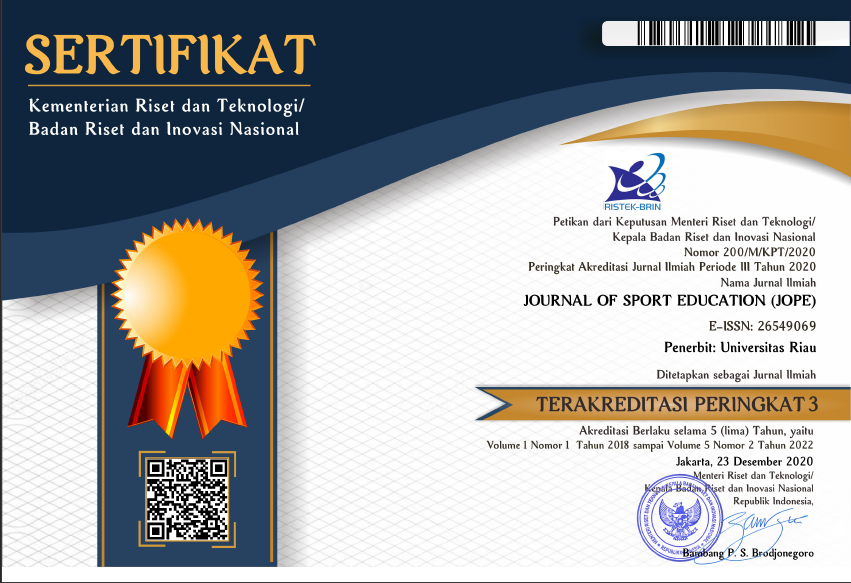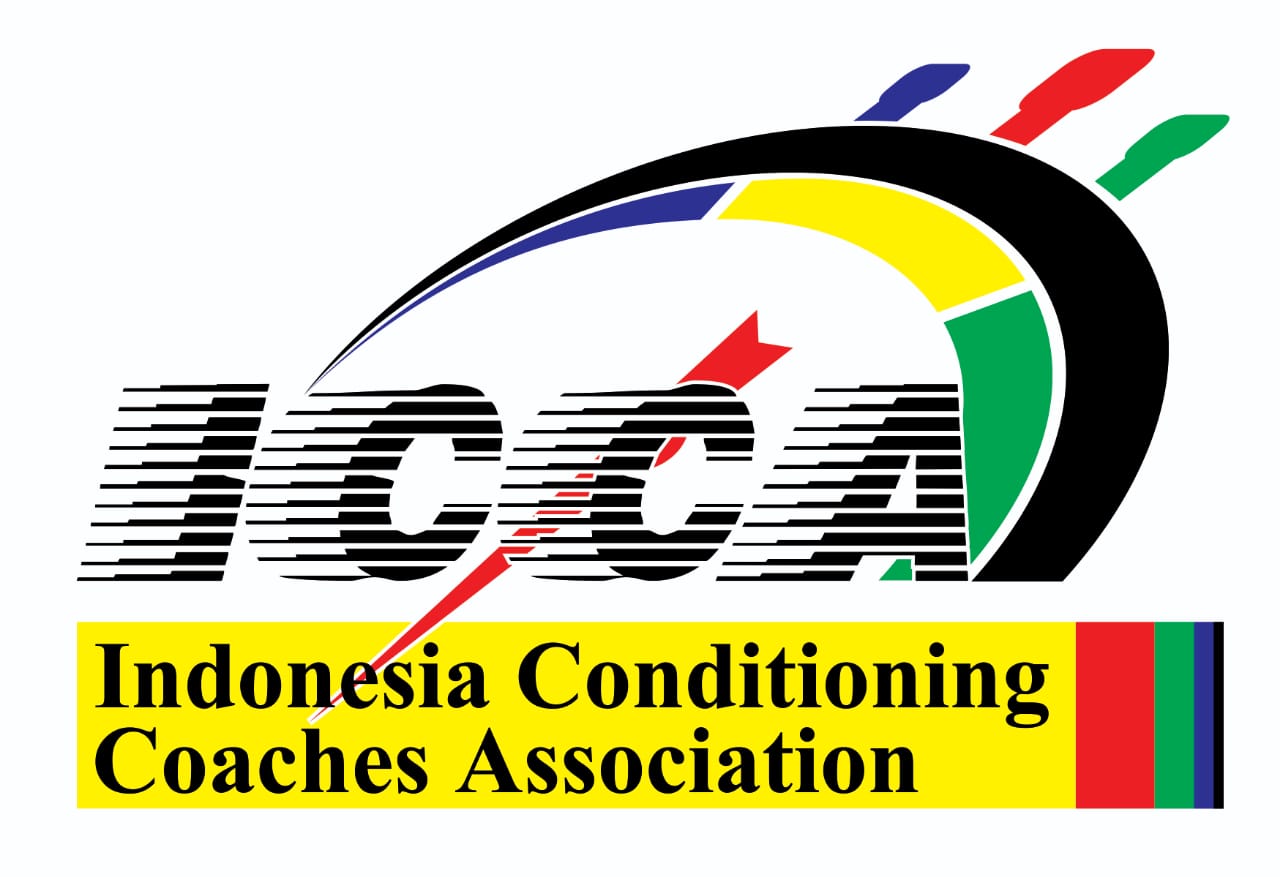The relationship between social interaction abilities and physical education learning participation of childrens with special needs on locomotor movements in inclusive elementary schools
Abstract
(English)
This study investigates the relationship between social interaction skills and physical education learning participation of children with special needs in locomotor movements in inclusive elementary schools. This research is a correlational study with a cross-sectional approach. The population in this study were all children with special needs in inclusive elementary schools in Rembang Regency. From 14 sub-districts in Rembang Regency, there are 205 inclusive elementary schools, with a total population of 1,333 students. The sampling technique used purposive sampling with inclusion and exclusion criteria so that 74 samples were obtained. The research instrument for social interaction skills and participation in physical education learning uses questionnaires and locomotor ability tests. From the research results it is known that 1) There is a positive relationship between Social Interaction Ability and Locomotor Movement; 2) There is a positive relationship between Physical Education Learning Participation of Students with Special Needs and Locomotor Movement; 3) There is a positive and significant relationship between Social Interaction Ability and Physical Education Learning Participation for Children with Special Needs and Locomotor Movement in Inclusive Elementary Schools in Rembang Regency using the multiple regression test. The conclusion is that there is a relationship between Social Interaction Ability and Locomotor Movement, Physical Education Learning Participation of Students with Special Needs and Locomotor Movement and Social Interaction Ability with Physical Education Learning Participation of students with special needs and Locomotor Movement in Inclusive Elementary Schools in Rembang Regency.
(Indonesian)
Penelitian ini bertujuan untuk menyelidiki hubungan antara kemampuan interaksi sosial dengan partisipasi pembelajaran pendidikan jasmani anak berkebutuhan khusus pada gerakan lokomotor di sekolah dasar inklusif. Penelitian ini merupakan penelitian korelasional dengan pendekatan cross sectional. Populasi dalam penelitian ini adalah seluruh anak berkebutuhan khusus di sekolah dasar inklusi di Kabupaten Rembang. Dari 14 kecamatan di Kabupaten Rembang yang mencakup 205 Sekolah Dasar inklusi, dengan total populasi sebanyak 1.333 siswa. Teknik sampling menggunakan purposive sampling dengan kriteria inklusi dan ekslusi sehingga didapatkan 74 sampel. Instrumen penelitian keterampilan interaksi sosial dan partisipasi dalam pembelajaran pendidikan jasmani menggunakan angket dan tes kemampuan lokomotor. Dari hasil penelitian diketahui bahwa 1) terdapat hubungan positif antara Kemampuan Interaksi Sosial dengan Gerakan Lokomotor; 2) Terdapat hubungan positif antara Partisipasi Pembelajaran Pendidikan Jasmani Siswa Anak Berkebutuhan Khusus dengan Gerakan Lokomotor; 3) Terdapat hubungan yang positif dan signifikan antara Kemampuan Interaksi Sosial dengan Partisipasi Pembelajaran Pendidikan Jasmani siswa berkebutuhan khusus dan Gerak Lokomotor di Sekolah Dasar Inklusi Kabupaten Rembang menggunakan uji regresi berganda. Kesimpulannya adalah terdapat hubungan antara Kemampuan Interaksi Sosial dengan Gerakan Lokomotor, Partisipasi Pembelajaran Pendidikan Jasmani Siswa Anak Berkebutuhan Khusus dengan Gerakan Lokomotor dan Kemampuan Interaksi Sosial dengan Partisipasi Pembelajaran Pendidikan Jasmani siswa berkebutuhan khusus dan Gerak Lokomotor di Sekolah Dasar Inklusi Kabupaten Rembang.
Copyright © The Author (s) 2023

Keywords
References
Ainnayyah, R., Maulida, R. I., Ningtyas, A. A., & Istiana, I. (2019). Identifikasi komunikasi anak berkebutuhan khusus dalam interaksi sosial. JPI (Jurnal Pendidikan Inklusi), 3(1), 48. https://doi.org/10.26740/inklusi.v3n1.p48-52
Amodia-Bidakowska, A., Laverty, C., & Ramchandani, P. G. (2020). Father-child play: A systematic review of its frequency, characteristics and potential impact on children’s development. Developmental Review, 57(March 2019), 100924. https://doi.org/10.1016/j.dr.2020.100924
Anggraeni, N. (2013). Survei partisipasi siswa berkebutuhan khusus terhadap pembelajaran penjasorkes di smplb dan smalb manunggal slawi kabupaten tegal tahun 2012. Active - Journal of Physical Education, Sport, Health and Recreation, 2(1), 265–269. https://doi.org/10.15294/active.v2i1.899
Barber, W. (2018). Inclusive and accessible physical education: Rethinking ability and disability in pre-service teacher education. Sport, Education and Society, 23(6), 520–532. https://doi.org/10.1080/13573322.2016.1269004
Chan, C. H. S., Ha, A. S. C., Ng, J. Y. Y., & Lubans, D. R. (2019). Associations between fundamental movement skill competence, physical activity and psycho-social determinants in Hong Kong Chinese children. Journal of Sports Sciences, 37(2), 229–236. https://doi.org/10.1080/02640414.2018.1490055
Chulvi-Medrano, I., Rial, T., Cortell-Tormo, J. M., Alakhdar, Y., Teixeira, C. V. L. S., Masiá-Tortosa, L., & Dorgo, S. (2017). Manual resistance versus conventional resistance training: Impact on strength and muscular endurance in recreationally trained men. Journal of Sports Science and Medicine, 16(3), 343–349. https://doi.org/10.1080/02640414.2018.14901212/
Febriyanti, N. R., & Pramono, H. (2022). Proses Pembelajaran Pendidikan Jasmani Adaptif Anak Berkebutuhan Khusus Anak Tunagrhita di SLB Negeri Cendono Kabupaten Kudus. Indonesian Journal for Physical Education and Sport, 3(1), 333–339. https://doi.org/10.15294/inapes.v3i1.48150
Finlay, M. J., Page, R. M., Greig, M., & Bridge, C. A. (2021). The prevalence of pre-conditioning and recovery strategies in senior elite and non-elite amateur boxing. Physician and Sportsmedicine, 00(00), 1–9. https://doi.org/10.1080/00913847.2021.1931525
Hayudi, & Mursalim. (2020). Inovasi pembelajaran (inklusi) pendidikan jasmani berbasis permainan kecil untuk mahasiswa berkebutuhan khusus. Jurnal Kejaora (Kesehatan Jasmani Dan Olah Raga), 5(2), 1–11. https://doi.org/10.36526/kejaora.v5i2.929
Ho, F. K. W., Louie, L. H. T., Hing-Sang Wong, W., Chan, K. L., Tiwari, A., Chow, C. B., Ho, W., Wong, W., Chan, M., Chen, E. Y. H., Cheung, Y. F., & Ip, P. (2017). A sports-based youth development program, teen mental health, and physical fitness: An RCT. Pediatrics, 140(4). https://doi.org/10.1542/peds.2017-1543
Hulteen, R. M., Morgan, P. J., Barnett, L. M., Stodden, D. F., & Lubans, D. R. (2018). Development of foundational movement skills: A conceptual model for physical activity across the lifespan. Sports Medicine, 48(7), 1533–1540. https://doi.org/10.1007/s40279-018-0892-6
Kiuppis, F. (2018). Inclusion in sport: Disability and participation. Sport in Society, 21(1), 4–21. https://doi.org/10.1080/17430437.2016.1225882
Kurniawan, A. (2018). Metodologi Penelitian Pendidikan. PT Remaja Rosdakarya.
Kurniawan, R., Pradana, I. A., & Heynoek, F. P. (2022). Pengembangan modul guru materi variasi dan kombinasi gerak lokomotor non-lokomotor manipulatif untuk siswa autis. Multilateral : Jurnal Pendidikan Jasmani Dan Olahraga, 21(2), 98. https://doi.org/10.20527/multilateral.v21i2.13161
Mora-Gonzalez, J., Esteban-Cornejo, I., Cadenas-Sanchez, C., Migueles, J. H., Molina-Garcia, P., Rodriguez-Ayllon, M., Henriksson, P., Pontifex, M. B., Catena, A., & Ortega, F. B. (2019). Physical fitness, physical activity, and the executive function in children with overweight and obesity. Journal of Pediatrics, 208, 50-56.e1. https://doi.org/10.1016/j.jpeds.2018.12.028
Mubarak, R. (2016). Efektivitas gerak lokomotor untuk meningkatkan kemampuan motorik kasar pada siswa tunagrahita sedang kelas iii sd di slb wiyata dharma 3 sleman. Jurnal Widia Ortodidaktika, 6(1), 12–19. https://doi.org/10.1080/02640414.2016.12517255/
Muzamil, M. S., Afriwardi, A., & Martini, R. D. (2014). Hubungan antara tingkat aktivitas fisik dengan fungsi kognitif pada usila di kelurahan jati kecamatan padang timur. Jurnal Kesehatan Andalas, 3(2), 202–205. https://doi.org/10.25077/jka.v3i2.87
O’Connor, J., & Penney, D. (2021). Informal sport and curriculum futures: An investigation of the knowledge, skills and understandings for participation and the possibilities for physical education. European Physical Education Review, 27(1), 3–26. https://doi.org/10.1177/1356336X20915937
Qi, J., & Ha, A. S. (2012). Inclusion in physical education: A review of literature. International Journal of Disability, Development and Education, 59(3), 257–281. https://doi.org/10.1080/1034912X.2012.697737
Rohmansyah, N. A. (2022). Challenge-based games’ impact on manipulative motor skills, direction-following, and body awareness in children with mental disabilities. Journal of Anthropology of Sport and Physical Education, 6(4), 7–9. https://doi.org/10.26773/jaspe.221002
Rosenberg, L., Moran, A., & Bart, O. (2017). The associations among motor ability, social-communication skills, and participation in daily life activities in children with low-functioning autism spectrum disorder. Journal of Occupational Therapy, Schools, and Early Intervention, 10(2), 137–146. https://doi.org/10.1080/19411243.2017.1304842
Runcharoen, S. (2014). The development of social interaction of children with autism in inclusive classrooms. Procedia - Social and Behavioral Sciences, 116, 4108–4113. https://doi.org/10.1016/j.sbspro.2014.01.899
Safitri, H., & Solikhah, U. (2020). Hubungan antara dukungan sosial dengan kemampuan interaksi sosial anak berkebu-tuhan khusus di slb c yakut purwokerto. Jurnal Keperawatan Muhammadiyah, 5(2), 302–310. https://doi.org/10.30651/jkm.v0i0.5619
Saqr, M., Fors, U., & Nouri, J. (2018). Using social network analysis to understand online problem-based learning and predict performance. PLoS ONE, 13(9), 1–20. https://doi.org/10.1371/journal.pone.0203590
Sato, T., & Haegele, J. A. (2017). Professional development in adapted physical education with graduate web-based professional learning. Physical Education and Sport Pedagogy, 22(6), 618–631. https://doi.org/10.1080/17408989.2017.1310832
Szumski, G., & Karwowski, M. (2014). Psychosocial functioning and school achievement of children with mild intellectual disability in polish special, integrative, and mainstream schools. Journal of Policy and Practice in Intellectual Disabilities, 11(2), 99–108. https://doi.org/10.1111/jppi.12076
Valentini, N. C., Pierosan, L., Rudisill, M. E., & Hastie, P. A. (2017). Mastery and exercise play interventions: motor skill development and verbal recall of children with and without disabilities. Physical Education and Sport Pedagogy, 22(4), 349–363. https://doi.org/10.1080/17408989.2016.1241223
Van Aart, I., Hartman, E., Elferink-Gemser, M., Mombarg, R., & Visscher, C. (2017). Relations among basic psychological needs, pe-motivation and fundamental movement skills in 9–12-year-old boys and girls in physical education. Physical Education and Sport Pedagogy, 22(1), 15–34. https://doi.org/10.1080/17408989.2015.1112776
Webster, E. K., & Ulrich, D. A. (2017). Evaluation of the psychometric properties of the test of gross motor development-third edition. Journal of Motor Learning and Development, 5(1), 45–58. https://doi.org/10.1123/jmld.2016-0003
Wick, K., Leeger-Aschmann, C. S., Monn, N. D., Radtke, T., Ott, L. V., Rebholz, C. E., Cruz, S., Gerber, N., Schmutz, E. A., Puder, J. J., Munsch, S., Kakebeeke, T. H., Jenni, O. G., Granacher, U., & Kriemler, S. (2017). Interventions to promote fundamental movement skills in childcare and kindergarten: a systematic review and meta-analysis. Sports Medicine, 47(10), 2045–2068. https://doi.org/10.1007/s40279-017-0723-1
DOI: http://dx.doi.org/10.31258/jope.6.1.49-59
Refbacks
- There are currently no refbacks.











